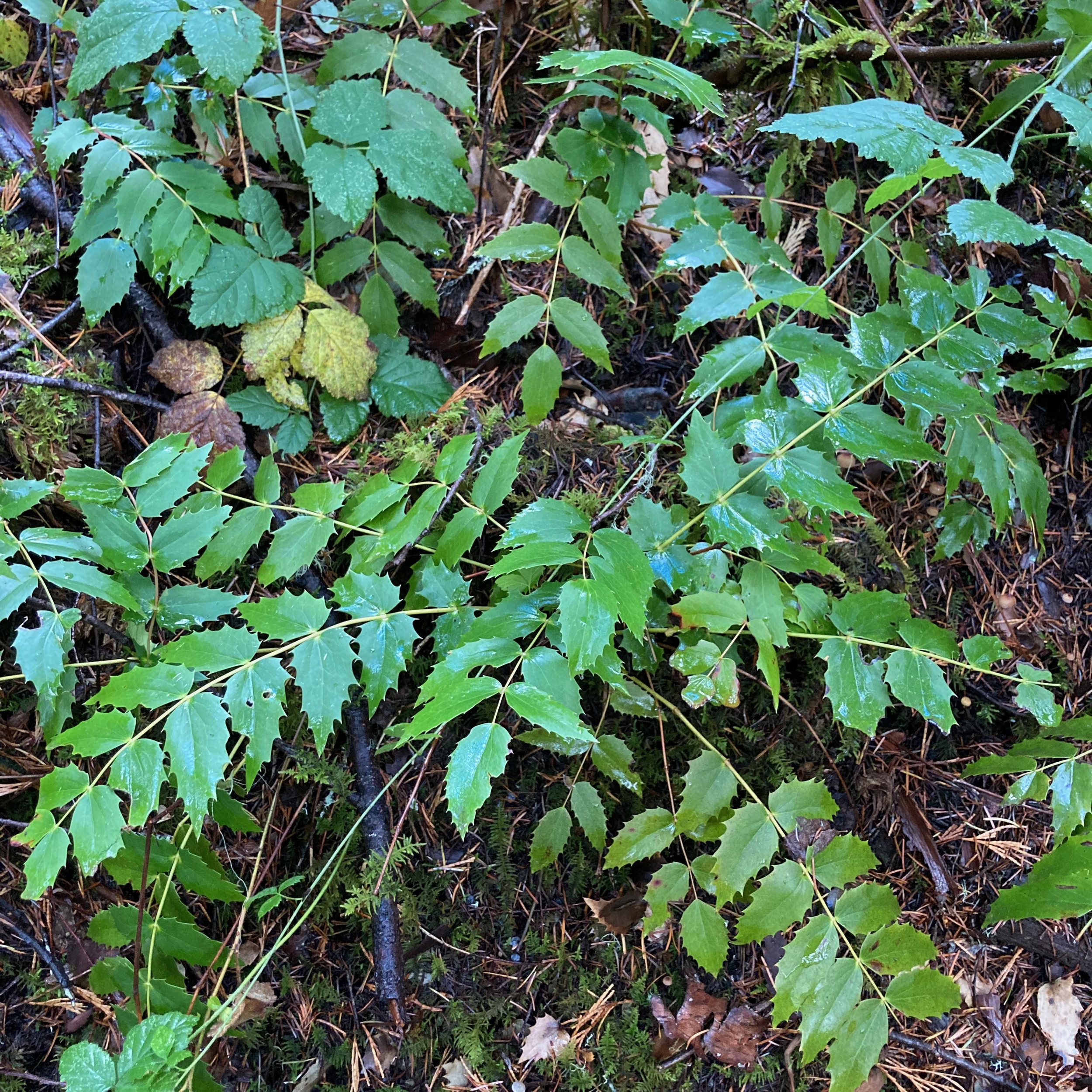
Oregon Grape Root
Identifying Oregon Grape
Marco surveys the Oregon Grape.
If you live in the Pacific Northwest, you are probably well acquainted with Oregon Grape. This bountiful evergreen shrub comes in a few varieties: Cascade Oregon Grape (Berberis nervosa), Shining Oregon Grape (Berberis aquifolium), and Trailing Oregon Grape (Berberis repens). While each one varies in size, growth pattern, and distribution, their evergreen, holly-like compound leaves are a distinguishing characteristic of all Oregon Grape species.
In the spring, Oregon Grape produces cheerful bunches of small yellow flowers. These beauties hint at the golden magic that lies beneath the surface of the forest floor where Oregon Grape roots travel. Their roots are rich in berberine, an alkaloid that has been traditionally used to fight infection. This alkaloid is so colorful that Oregon Grape root is useful as a natural dye. Taken internally, its golden glow has a particular affinity for the liver, skin, and digestive system (Kloos, 2017).
Wellness Properties of Oregon Grape Root
Harvest only from abundant stands.
According to naturopathic doctor JJ Purcell, Oregon Grape improves digestion, assimilation, and metabolism (Purcell, 2015). Indeed after several days of taking it regularly before meals, Seth just skipped a day, and his belly is feeling the difference. We like to take it about 15 minutes before a meal as a bitters to prime our systems for digestion.
Oregon Grape is also considered a blood purifier. According to Purcell, Oregon Grape helps the liver do its work, “liberat[ing] iron from the liver to enter the bloodstream to boost hemoglobin levels” (2015).
Because of all of the support Oregon Grape offers our digestion, blood, and metabolism, it also promotes skin health by eliminating toxins before they are forced to exit through the skin. Folks with dry, itchy skin conditions may benefit from regular use of Oregon Grape’s magic (Kloos, 2017).
Oregon Grape has also traditionally been used to address diarrhea. Its antimicrobial properties may help solve the problem quickly, especially if it is the result of a bacterial infection. In addition, Kloos recommends Oregon Grape root tincture or tea if you have “food sensitivities or allergies, are prone to constipation, wake up feeling groggy and listless in the morning, have bad breath with a coated tongue, and/or have chronic itchy skin conditions” (2017).
Harvesting Oregon Grape Root
If you want to harvest your own Oregon Grape root, go for it! While it is abundant in many areas of the Pacific Northwest, please harvest with the same degree of intention as you would any other plant. Ask permission before pulling up any rhizomes. Harvest no more than one in ten. Gather only what you need. Give gratitude to the plants for supporting your wellness journey.
You can harvest Oregon Grape root any time between mid-spring (after flowering) and mid-autumn. When you find a healthy looking plant, give a gentle tug. If its roots come up easily for you, follow them until they break off or you’ve gotten a motherload. Keep the underground part for yourself. To replant the aboveground part, take off the leaves and replant.
Make Your Own Oregon Grape Root Potions
Our Oregon Grape Root Tincture.
While the roots are still fresh, cut them into 1/4-inch-long pieces and make a fresh-root tincture or tea out of them. If you want to dry them for future tea or tincture projects, you can cut them into 1/2- to 1-inch pieces. Be sure to cut them fresh, though! They get woody when they dry and become quite difficult to cut.
For fresh tincture, follow the instructions for making a fresh herb tincture here. For tea, simply put about two teaspoons per cup of hot water into a pot and simmer, covered, for 15 minutes. Feel free to add licorice or other delicious herbs, roots, or berries to church it up. If your belly is extra rumbly, you may want to combine it with peppermint and ginger and sip on it throughout the day.
And if you want to bring even more of its magic into your life, consider dying some fabric or yarn with Oregon Grape root!
Resources
Kloos, Scott. 2017. Pacific Northwest Medicinal Plants. Timber Press: Portland, Oregon.
Purcell, JJ. 2015. The Herbal Apothecary: 100 Medicinal Herbs and How to Use Them. Timber Press: Portland, Oregon.
Disclaimer
For educational purposes only. This information has not been evaluated by the Food and Drug Administration. This information is not intended to diagnose, treat, cure, or prevent any disease.



